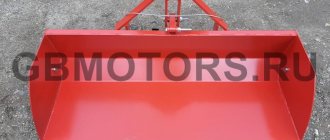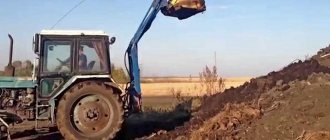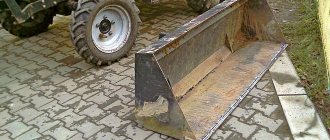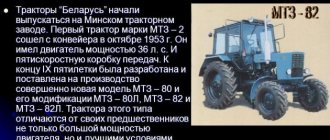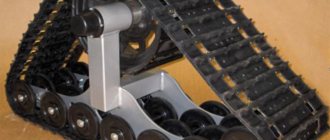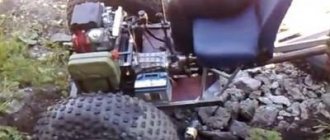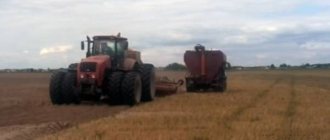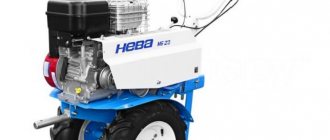KUHN on MTZ-80, 82: rear linkage
The main differences between the MTZ-80 and MTZ-82 attachments.
Main technical characteristics of KUNs for MTZ. One of the most common and simplest types of special attachments, of course, can be called KUN at MTZ, which has become a kind of popular name - a common name for any similar type of attachments for tractors. KUN is a universal mounted hay hauler, which is essentially a tractor front-end hydraulic loader for moving, lifting and lowering various large loads.
However, if KUN is initially a hay hauler, this does not mean that it cannot work with other loads and materials that are not even remotely included in the category of hay and silage, and are not related to agricultural work. The range of application of tractors with similar attachments is very wide and varied. For example, in the same excavation work, it is capable of moving large masses of soil from one place to another, covering any distance. Advantages of front mounted equipment and technical capabilities
Slightly different equipment is installed on different modifications of Belarusian tractors, with minor technical and operational changes. Here the ratio of the load capacity and the canopy sweep may vary, which in one way or another directly affects the operation of the equipment and its tasks during operation.
1. MTZ - 80 with KUN is equipped with a prototype of the PF - 1 attachment, which has the following technical characteristics:
- weight of lifted loads up to 1 ton;
- lifting height limit up to 3.5 meters;
- the weight of the loader itself is 900 kg;
- maximum speed of cargo movement is up to 20 km/h.
2. MTZ-82 with KUN is equipped with a more advanced PKU-0.8 device than its prototype, which is somewhat narrower than its predecessor and lacks some parts, which include the so-called “rocker” with a quick-change mechanism.
- weight of lifted loads up to 800 kilograms;
- high-rise ceiling up to 3.5 meters;
- weight of the mounted loader up to 700 kg;
- maximum travel speed with load up to 20 km/h.
Types of KUN buckets for tractors
A tractor with a bucket is a multifunctional unit capable of performing many diverse tasks.
A tractor bucket is a type of loader for heavy equipment. According to the principle of operation, this is a standard front loader; a hydraulic system is responsible for its operation. KUHN turns equipment into an excavator, tractor loader, leveler or bulldozer.
The universal mounted bucket (KUN) was originally manufactured for the purpose of loading silage or hay. But the scope of application of this equipment has expanded significantly, which is why they are actively used in warehouses for transporting goods, in construction, for landscaping, and for snow removal.
Advantages of a tractor front loader:
- Convenient for maintenance, since all components are within reach and can be easily replaced;
- Quick installation and dismantling of various canopies;
- Reliable (this is not always the case with a homemade loader);
- High load capacity;
- The reinforced hydraulic system simplifies the operation of the unit.
Popular KUHN models
Depending on the load capacity and fastening system, there are two current KUN models:
- PF-1. Has its own supporting frame. Such a KUN for a tractor is mounted on the rear linkage. This minimizes the risk of the machine overturning when handling large loads;
- PKU-08. The equipment is compact and ergonomic and is mounted on a semi-frame. In this case, the balance of the tractor is disrupted and it can easily tip over.
The KUN for equipment has the shape of an arrow, which is controlled by four hydraulic mechanisms - two help lift loads and two control the angle of inclination of the bucket. The drive is taken by the chassis, the system of which acts as a connector for attaching the bucket to the machine. All loader controls are located in the operator's cabin and are not complicated.
You can choose other additional canopies to equip a tractor with KUHN:
- Buckets with a volume in the range of 0.35 - 1.5 m3;
- A fork device that performs work in agriculture and during loading;
- Log grabber. With its help, the equipment can be actively used for collecting firewood;
- Clamps for bales and rolls;
- Rake bars that help remove hay and hay;
- Jaw blade.
Basic parameters of a tractor with a bucket:
- The rake grid and other aggregated working parts have a load capacity of 500 and 800 kilograms;
- Loading height with a bucket and rake grid – 2.5 and 3.5 meters;
- The angle when unloading the bucket is 55 – 65 degrees.
The dimensions and performance of the bucket determine the chassis parameters. It is used to attach equipment to the tractor.
Homemade ladle
You can make a KUN for a mini tractor with your own hands, while saving money on the purchase of this device. You need to acquire a metal sheet (with a thickness of six millimeters), metal scissors, welding, iron pipes of various diameters.
The KUN for the tractor is made according to a simple scheme:
- The fasteners are welded to the box and motor. The structure is reinforced from below with a metal corner;
- The KUHN itself is manufactured. It is enough to cut a sheet of metal into rectangles, which are then welded into one structure. Welding must be of high quality so that the finished structure lasts longer. Pipes and rods with a diameter of 10 and 5 centimeters, respectively, are suitable for the racks;
- Installation of hydraulic booster. For its mobility, a sleeve with a diameter of about 3 centimeters is suitable;
- The support pipe is welded to the front of the unit, then the racks are combined and reinforced with “kerchiefs”;
- For normal rotation of the bucket, a cylinder installed on the right is used.
To make your own bucket, you need to know how to use welding and understand mechanics. If in doubt, it is better to purchase ready-made equipment that can be attached to the Kioti tractor and other popular models of equipment.
Operating rules
During the manufacture of a front loader, manufacturers pay due attention to the safety of the operator during operation. When using small machines, you need to monitor the overload so that the small equipment does not tip over. This can be prevented by installing protective systems.
It is also worth following simple recommendations when operating a tractor with a bucket:
- When moving, the scoop must be in the down position;
- It is important to ensure that the KUN is lifted correctly during operation;
- Special equipment (including a tractor with two buckets) must be used strictly for its intended purpose.
Difference in attachments
If the PKU - 0.8 is attached directly to the tractor frame, naturally disrupting the uniformity of the load during operation and putting pressure on the frame with the entire loaded mass, which leads to premature breakdowns when working with heavy loads, then the PF - 1 is equipped with its own frame, attached under the tractor to the rear axle , which evenly distributes the entire load.
In addition, PF-1 uses slightly more powerful cylinders, while the boom and other parts with mechanisms are made from reinforced (thickened) metal. Consequently, despite all the external similarities, the KUN on MTZ of different models still has significant differences in operation.
Note
Many skilled mechanics make the KUNS they need with their own hands, producing quite working and acceptable attachments. This does not mean that it is necessary and possible to refuse to purchase a high-quality factory product, but it does not exclude this possibility.
However, any homemade KUHN, even one manufactured according to all the rules and regulations, is certainly technically inferior to its factory-made counterparts.
KUHN for the rear linkage of a tractor: what equipment can be used
The homemade product installed on a mini tractor with KUN can be of two types:
- Equipment type PF-1, which has its own supporting frame. This homemade KUN is attached to a tractor, which protects the machine from overturning. Such equipment weighs about 900 kg, is driven by hydraulic cylinders, has a load capacity of 1 ton and a speed of 20 km/h.
- The PKU-08, which is a more modern modification of the PF-1, is also installed on the rear linkage of the MTZ 82. It is not difficult to attach a homemade KUN or a KUN assembled by your own to a tractor. But it is worth considering that PKU-08 differs from MTZ in carrying less load than the previous arm of the equipment. The PKU-08 weighs only 700 kg, reaches a speed of up to 20 km/h, and is capable of lifting 800 kg of cargo at a time.
The kuna model on MTZ 80 or MTZ 82 is produced at the Salskselmash plant, which specializes in agricultural machinery. KUN 10 is a functional and practical boom, created specifically for the specified MTZ models. Kun can also be installed on a Chinese tractor. Although the equipment works better with Minsk technology. Among the advantages of KUN 10 it is worth noting such characteristics as:
- Versatility. The Belarus tractor is capable of being a loader and performing earth-moving work like an excavator. The machine is also used as a bulldozer or leveler.
- Compactness. The installation of KUN 10 at MTZ allows the equipment to be used in the city and on small construction sites. Therefore, such a tractor is constantly used for landscaping territories, digging holes and trenches, laying communications, etc.
- High level of productivity.
- Reliability.
- Ease of use.
- Easy to use.
How to make a kun ladle with your own hands - Metalist's Handbook
A tractor bucket is a type of loader for heavy equipment. According to the principle of operation, this is a standard front loader; a hydraulic system is responsible for its operation. KUHN turns equipment into an excavator, tractor loader, leveler or bulldozer.
The universal mounted bucket was originally made for the purpose of loading silage or hay. But the scope of application of this equipment has expanded significantly, which is why they are actively used in warehouses for transporting goods, in construction, for landscaping, and for snow removal.
Advantages of a tractor front loader:
- Convenient for maintenance, since all components are within reach and can be easily replaced;
- Quick installation and dismantling of various canopies;
- Reliable (this is not always the case with a homemade loader);
- High load capacity;
- The reinforced hydraulic system simplifies the operation of the unit.
Kun, buckets, loaders and other attachments for mini tractors, drawings
The presence of a mini-tractor on a livestock farm or small agricultural enterprise today will not surprise anyone. Such equipment is needed every day to perform a range of agricultural and construction tasks.
From soil preparation and sowing to clearing the area of debris, snow, and remnants of building materials.
The use of various attachments allows you to further expand the functionality of compact agricultural machinery:
- bulldozer dumps;
- front loaders;
- excavator units and buckets;
- cultivators and harrows;
- tedder;
- sevalok.
The devices are controlled hydraulically and, due to their universal design, can be used with different models of mini-tractors.
Mounted universal hay hauler (kun)
Like other types of attachments, a mini tractor attachment is designed to increase the functionality of an agricultural machine. It significantly expands the farmer’s capabilities and makes it easier to perform various tasks. This arrow-shaped front linkage allows you to:
- load hay bales, silage, straw, rolls of roofing felt, building materials;
- perform earthmoving and road work;
- facilitate suburban construction and renovation.
Characteristics of a homemade unit
Homemade KUN for a mini tractor: installation features. The manufacturer offers buckets of various sizes, fork equipment (needed for agriculture and loading and unloading), rake grids for collecting hay, straw, and mown grass. Grabs for logs are sold separately, so KUNs are used for logging. Additionally there are grippers for bales and rolls. You can also find jaw dumps in stores. The basic equipment for a homemade KUN for a mini tractor may vary.
The dimensions of KUN 10 can be different, depending on the modification of the equipment. The carrying capacity of the rake grid, dumps and grabs is 500 and 800 kg. The equipment bucket rises to a height of 2.5 m, and the rake grid - to 3.5 m. The unloading angle of the bucket, on average, ranges from 55 to 65º. The performance and size of the equipment depend on the chassis that needs to be mounted on a homemade mini tractor or other self-propelled unit.
Buying attachments is expensive, so you can make a KUN for MTZ with your own hands. Assembling and installing such a tool is simple, you just need to draw up a diagram of the equipment and mark on it the place where it will be mounted on the wheeled tractor. A homemade KUN is attached to the rear linkage of an MTZ 80 or 82. This is much easier than installing a KUN 10, which is available in a front modification.
A homemade tractor differs from a factory one and has several significant advantages:
- Ease of mounting.
- Selection of the length and height that is necessary for specific work on the ground or at a construction site.
- You can use scrap materials left over from other equipment.
In order to make a KUN for a homemade or factory tractor, you need to stock up on the following equipment:
- welding machine;
- tools for cutting and cutting metal;
- sledgehammer;
- hammer;
- wrenches.
If you have no welding experience, then you should find a specialist who knows how to work with the machine. This determines the quality and reliability of welding seams, on which the installation and duration of use of the KUN largely depends.
How to make a homemade bucket for a mini tractor
As a rule, you make a bucket for a tractor yourself using a special hydraulic installation, as well as adjustable supports. This makes it possible to make the operation of the tractor more reliable, and control of the attached equipment as simple as possible.
Making a bucket for a mini tractor with your own hands is not so difficult. Many farmers who have already done this post their work online, so finding diagrams and drawings related to the design is quite possible.
Those who have made attachments themselves argue that you will first need to make the most reliable load-bearing element. As a rule, its role is played by a frame made of metal corners welded together. Sometimes it is permissible to use a frame that was on an old mini tractor (if you had one).
In addition, you need to take care of installing a special support platform, which is attached to the sides of the installed frame. It is necessary to ensure the presence of support shoes that will prevent the tractor from tipping over when working with the bucket. To construct them, you need to use metal pipes, the diameter of which is about 10 cm.
In addition, you need to make the ladle itself. Usually, for this purpose, metal sheets are used, bent to the desired shape, as well as 2 pairs of hydraulic cylinders, thanks to which you can make a lifting boom. In some cases, it is allowed to use hydraulic units borrowed from trucks.
It is possible and not even very difficult to make a bucket for a mini tractor yourself, but this process is labor-intensive and can take a lot of time. In addition, if you are not confident in your abilities and have never done anything like this before, it may be better for you to go to a store and buy a structure there. If this is not your first time making something and you strictly follow the drawings, then when welding of good quality, such a homemade product will not be inferior to the finished product made by the factory, either in performance or in reliability of use.
How to make a KUN for MTZ with your own hands
It is imperative to make drawings of a homemade KUN so that there are no problems with cutting the metal into individual elements. Let's look at how to make such equipment yourself:
- You will need profiles and sheet metal. The thickness of the materials must correspond to the load that is planned.
- You will need to purchase several hydraulic cylinders - 2 large ones to lift the bucket, and 2 smaller ones. They are needed to adjust the inclination level and equipment parameters.
- Cylindrical joints, without which it is impossible to assemble the entire structure of the wheel unit.
When you have all the necessary tools and materials, you can begin the process of assembling the KUN with your own hands.
You can find drawings and diagrams on the Internet, on specialized forums and websites, or you can create them yourself.
This will allow you to cut the metal so that there is a minimum amount of waste. You can contact design firms, where employees will help you create a good drawing of the future attachments for the tractor.
The loader must consist of two rectangular frames. One of them - the external one - should be larger. It is this that is aggregated, i.e. Attaches to the rear tractor of the tractor. The inner rectangular frame is cut from sheet iron. Large hydraulic cylinders must be welded to the bottom of the frame, and a spacer must be installed on top. It is needed to create a stiffening rib.
The majority of the structure is the boom attachment, accounting for more than 70%. To install it, you will need the help of another person who should know how to install it correctly. The product is placed closer to the frame and connected to the cylinder. Then you need to attach the middle part to it, after which the bucket is hung. It is worth taking into account such an important nuance as the relationship between the length of the boom and the stability of the tractor. If the boom radius is more than 2 m, then a counterweight must be installed on the front frame. This will allow the MTZ to stand firmly on the ground and not tilt in different directions while carrying loads.
The installed bucket is made independently, also from sheet metal. The elements must be welded so that a structure similar to a boomerang is obtained. It should have 3 attachment points - in the center and along the edges.
How to build a KUN on MTZ-82 yourself and is it worth doing?
MTZ 82 with KUN is used in construction, agriculture and for loading and unloading operations. KUN at MTZ is considered the most common type of attachment. There are several varieties of this equipment; in addition, folk craftsmen often make homemade KUN. In this article we will tell you what a KUN is, look at popular models and figure out how to make a KUN for the MTZ-82 tractor with your own hands.
What is KUN?
This abbreviation stands for universal mounted hay hauler, although in essence it is a front-end loader that operates from a hydraulic system.
Initially, this device was intended for loading hay or silage. But in fact, KUN for MTZ-82 can work with almost any load that is suitable in size. For example, such equipment is widely used for moving goods in warehouses and for performing excavation work.
Varieties of KUN
The MTZ-82 tractor is mainly aggregated with two types of KUN. The difference between these mechanisms is insignificant and lies in the load capacity and the method of attaching attachments. Let's look at each unit in more detail.
PF-1
This type of front loader has its own supporting frame. The equipment is mounted on the rear axle of the MTZ-82 tractor. This fastening scheme eliminates the possibility of turning the tractor over when working with a large load.
All components are made of high-strength metal, the KUN is driven by two powerful hydraulic cylinders.
This KUN, installed on the MTZ-82 tractor, is a modification of the previous model. The design turned out to be more compact and ergonomic.
Compared to its predecessor, this device has a significant drawback. This is a fastening method and a relatively small load capacity. The unit is attached directly to the semi-frame of the tractor; accordingly, the balancing of the machine is disrupted and the risk of tipping over increases.
Homemade KUN for the MTZ-82 tractor
Some farmers prefer to make such attachments with their own hands. If you have certain skills, this is quite easy to do.
Among the advantages of self-made KUNs, one can note the minimal financial costs and the ability to independently determine the length of the boom reach. It is worth noting that a long boom and excessive load can lead to the tractor tipping over. Therefore, when the load is heavy, it is recommended to install counterweights on the front half-frame.
Homemade KUNs also have disadvantages; these products are significantly inferior in performance to factory models.
The manufacturing process can be divided into two stages. Let's look at each in more detail.
Having decided to make a KUN for the MTZ-82 tractor with your own hands, you must first take care of the materials and tools. You will need:
1. Sheet metal. The thickness depends on the tasks performed, but it must be taken into account that too thick iron will significantly make the structure heavier.
2. You need to get three hydraulic cylinders. They can be removed from any old equipment. A large cylinder will be responsible for the boom reach, two small ones for the angles of inclination of the bucket.
3. Hinged joints. To determine their number, it is recommended to draw up a preliminary drawing of the entire structure.
4. To make a ladle you will need a welding machine and a gas cutter.
5. Auxiliary tools you may need are wrenches and adjustable wrenches, a chisel and a hammer.
Manufacturing process
The basis for attaching the KUN to the MTZ-82 tractor consists of two rectangles. The outer rectangular frame will connect to the rear linkage system of the tractor. The internal frame is made of two sheets of metal. A large hydraulic cylinder for the boom will be attached to the lower part, and a stiffening rib made in the form of a spacer will be located at the top.
Then you need to make an arrow with your own hands. This is a composite structure, so the recommended parameters look like this: 70% of the total length is the main part. It should be closer to the frame and connected to the large cylinder.
The middle part is attached to the base using hinge joints, to which, in turn, the loader bucket will be attached. Thus, you should end up with a structure that resembles a boomerang and has three attachment points: at the ends and in the center.
The ladle is made from sheets of prepared metal, the dimensions are determined depending on the intended application. To make the MTZ-82 tractor more functional, you can make a forklift with your own hands, which will replace the bucket if necessary.
If you plan to extend the boom to a height of more than two meters, a counterweight must be installed on the front half-frame. You can make it yourself from concrete blocks or sandbags.
Pros and cons of making a homemade kun for a tractor
A tractor kun is a useful equipment for farming that allows you to level the top layer of soil, break up rubbish heaps and load trucks. Of course, such multifunctional special equipment is quite expensive. In this regard, many enthusiastic farmers decide to assemble a loader themselves, especially since making a kun for a tractor is not as difficult as it seems.
The most important advantage of a homemade kun is its low cost. Naturally, you will have to spend a little money during assembly, but at the final price, homemade tractor loaders will still be significantly inferior to their factory-made counterparts.
Homemade loader for the rear linkage of an agricultural machine
This homemade bucket is considered the simplest option for use on T-25, T-40 tractors and other units whose design includes a rear linkage mechanism. This kun differs from a front loader in its ease of manufacture and installation on a tractor.
At the first stage of production, you will need to carefully study the drawings. They must indicate the size of each part used, as well as the method and sequence of its fixation in the overall structure.
After studying the diagrams, you will need to prepare the materials necessary for the work.
These include:
- metal profile and steel sheets - these will be used when assembling the base of the loader. The thickness of the metal used should be selected taking into account the size of the kun;
- swivel cylindrical joints – also selected based on the dimensions of the loader;
- 3 cylinders taken from the hydraulic system of any equipment unnecessary on the farm. Two of them must adjust the angle of the bucket. The third and largest cylinder is responsible for raising and lowering the boom.
From those used during work you will need:
- large hammer, mounting bolts, washers;
- screwdrivers, wrenches, pliers;
- powerful welding machine;
- gas cutter or grinder, capable of providing a perfectly even cut of metal parts.
The tractor loader is manufactured in the following order:
- First you need to assemble a base that is reliable and resistant to heavy weight. It should be taken into account that the frame will hold not only the bucket, but also the load it carries. The base of the kun should look like a rectangle assembled from square pipes. The lower part of the frame must be fixed to the tractor's hinged mechanism in such a way that it protrudes slightly beyond its edges. In the middle part of the frame you will need to install another rectangle welded from pipes. Next, you will need to install the largest cylinder on the inner rectangle. In its upper part you will need to first make 4 hinged joints to fix the boom, and a spacer;
- Next, the homemade loader must be equipped with a boom. It is assembled from a metal profile, the parts of which must be attached to each other at an angle of 30⁰. The hydraulic cylinder mount and the ends of the previously created base will need to be welded into the upper part of the boom;
- In the middle part of the boom you will need to install a hinge mechanism with a cylindrical shape. 2 movable joints are mounted into the mechanism, fixing 2 smaller cylinders together, as well as a crossbar used to install the bucket;
- The last step is to assemble the tractor bucket. To make it, you need to use one large steel sheet and 4 smaller parts. You will need to cut out rectangles from them, which, in the future, need to be welded to each other. In this case, the front sheet must be welded to the overall structure of the bucket at a certain angle. The video will tell you more about the manufacture of the loader.
During manufacturing, it must be remembered that a loader whose boom exceeds 2 meters in length will outweigh the tractor. To prevent this from happening, the front part of the agricultural implement will need to be weighted.
Homemade bucket for the rear or front hitch of a tractor
/ Tractors /
To carry out work on large farms or personal farms, it is impossible to do without process automation.
Loaders make it easier to carry out work on land management, clearing the area of unnecessary debris, loading crops, and transporting various cargoes.
The industry has launched the production of several models of such devices, but if there is a lack of funds to purchase them, you can make a loader for the rear linkage of a tractor yourself.
Front loaders for tractor Belarus 82.1 | Topic author: Charvi
We discuss the designs, advantages and disadvantages of the front loader equipment available on the market for Belarus tractors.
MTZ (Abheek) Front-end loader MKDU82B Agramak The basic equipment of the MKDU-82B series machines is based on the use of a new generation of front-end, wide-universal loaders with a quick-release hydraulic lift and semi-automatic change of working parts. Main advantages: - Hitching or detaching the loader from the tractor - within 2-3 minutes without using tools.
— The support included in the basic package (frame for mounting the working tools) allows you to change the working tool (bucket, forks, etc.) in 1 minute without using tools.
Reliable locking of the working element is carried out by lightly turning the lock handle. — The mechanical parallelogram ensures maximum parallelism between the lifting of pallets and the closed bucket.
— To protect the loader and tractor from overloads, an overpressure valve is provided in the hydraulic system. — The hydraulic lift is connected to the tractor’s hydraulic system using hydraulic quick-release connectors without the use of tools.
— The mechanism for connecting the hydraulic lift panels to the frame with a wedge gate ensures long-term and reliable operation without backlash.
— All articulated joints have a lubrication system, which increases the service life of the loader.
Characteristics: Weight of the loader without working parts, kg 650 Lifting height of the loader boom at the lower hinge, m 3, 8
Load capacity, kg 1000
Homemade bucket for the rear hitch of a tractor
Popular KUHN models
Depending on the load capacity and fastening system, there are two current KUN models:
- PF-1. Has its own supporting frame. Such a KUN for a tractor is mounted on the rear linkage. This minimizes the risk of the machine overturning when handling large loads;
- PKU-08. The equipment is compact and ergonomic and is mounted on a semi-frame. In this case, the balance of the tractor is disrupted and it can easily tip over.
Design Features
The KUN for equipment has the shape of an arrow, which is controlled by four hydraulic mechanisms - two help lift loads and two control the angle of inclination of the bucket. The drive is taken by the chassis, the system of which acts as a connector for attaching the bucket to the machine.
All loader controls are located in the operator's cabin and are not complicated.
You can choose other additional canopies to equip a tractor with KUHN:
- Buckets with a volume in the range of 0.35 - 1.5 m3;
- A fork device that performs work in agriculture and during loading;
- Log grabber. With its help, the equipment can be actively used for collecting firewood;
- Clamps for bales and rolls;
- Rake bars that help remove hay and hay;
- Jaw blade.
Basic parameters of a tractor with a bucket:
- The rake grid and other aggregated working parts have a load capacity of 500 and 800 kilograms;
- Loading height with a bucket and rake grid – 2.5 and 3.5 meters;
- The angle when unloading the bucket is 55 – 65 degrees.
The dimensions and performance of the bucket determine the chassis parameters. It is used to attach equipment to the tractor.
You can get acquainted with the specifics of how special equipment works with buckets in the video.
Valentin Kozhedub | Topic author: Rebeca
testing a loader as a crane.
V (Caris) why suddenly? ! the hitch is designed for lifting loads! from the front frontal you can break it faster. and in this version, if you start to take a heavy load, then the tractor just rears up and that’s it.
Maxim (Rebeca) and my papalam was breaking the gap
V (Caris) is it really from the rear load? This means the gap was cracked, and the loader finished it off.
Maxim (Rebeca) didn’t stick a knife in the front, but pushed the loaded cart and broke it. Who did I buy this tractor from? I tore out the central screw with a piece of the hydraulic tank; he had a bucket hanging on it
V (Caris) I sympathize... anything can happen...
What is important to consider when producing a hitch?
It is advisable to start manufacturing special equipment if you have the necessary materials and tools. It is important to correctly evaluate the craftsman’s experience with a welding machine and other metalworking devices.
Diagram of the hinged mechanism
The first stage in the production of equipment for a tractor is the preparation of the necessary drawings. You can simplify the task by taking a freely available standard document. The specification contains the necessary parts, indicating their sizes. Using it, the calculation of the material required for the manufacture of a homemade loader, as well as metal fasteners, is made.
A mini-tractor loader manufactured in accordance with the drawing and technology will be an excellent assistant in your work.
Loader for the rear linkage of a tractor: do it yourself, drawing.
As practice shows, a homemade loader with a rear linkage... The first will be responsible for changing the angle of the bucket, the second - for lifting; ...
Operating rules
During the manufacture of a front loader, manufacturers pay due attention to the safety of the operator during operation.
When using small machines, you need to monitor the overload so that the small equipment does not tip over. This can be prevented by installing protective systems.
It is also worth following simple recommendations when operating a tractor with a bucket:
- When moving, the scoop must be in the down position;
- It is important to ensure that the KUN is lifted correctly during operation;
- Special equipment (including a tractor with two buckets) must be used strictly for its intended purpose.
When purchasing a mini tractor, you should make sure that important options and elements are available. So, if necessary, it is enough to purchase a tractor bucket and other canopies that can be attached to special equipment.
Homemade ladle
You can make a KUN for a mini tractor with your own hands, while saving money on the purchase of this device. You need to acquire a metal sheet (with a thickness of six millimeters), metal scissors, welding, iron pipes of various diameters.
The KUN for the tractor is made according to a simple scheme:
- The fasteners are welded to the box and motor. The structure is reinforced from below with a metal corner;
- The KUHN itself is manufactured. It is enough to cut a sheet of metal into rectangles, which are then welded into one structure. Welding must be of high quality so that the finished structure lasts longer. Pipes and rods with a diameter of 10 and 5 centimeters, respectively, are suitable for the racks;
- Installation of hydraulic booster. For its mobility, a sleeve with a diameter of about 3 centimeters is suitable;
- The support pipe is welded to the front of the unit, then the racks are combined and reinforced with “kerchiefs”;
- For normal rotation of the bucket, a cylinder installed on the right is used.
To make your own bucket, you need to know how to use welding and understand mechanics. If in doubt, it is better to purchase ready-made equipment that can be attached to the Kioti tractor and other popular models of equipment.
Bucket for the rear linkage of the tractor. —
- 1 min. — Added by user jenya kapitanBucket on the rear linkage of the tractor. jenya kapitan ... Rear-mounted loader (review, dimensions). — Duration: 15:39. Andrei35355 63,615 …
Technology for the production of tractor attachments
First you need to prepare the base. It is a rectangle formed by square pipes or corners. Another rectangle is fixed in the center of the base, where a large hydraulic cylinder will be installed. A spacer and four hinges (for the cylinders and the boom mechanism) are fixed on the top edge.
Tractor boom diagram
The boom is made of two metal profiles connected at an angle of 30 degrees. The end of the base and the hydraulic cylinder mount are fixed to it (from above).
A cylindrical hinge is installed in the middle of the boom. Movably fixed sections are also mounted here, connecting small cylinders and a crossbar necessary for attaching the base of the bucket.
A ladle is made from one large and four smaller steel rectangular plates, one of the sheets is welded at an angle.
If the boom is more than two meters long, there is a high probability that the tractor may tip over. To eliminate a possible problem, the front part of the special equipment is equipped with a counterweight.
MTZ front end counterweight kit
| Share on social networks: |
Manufacturing a front loader for a tractor
The front loader differs from the previous bucket in that it is mounted on a mounted mechanism located in the front of the tractor. In the future, such an excavator can be actively used for snow removal, leveling the site and clearing debris.
As in the first case, before manufacturing the loader you will need to study the drawings. They must be as accurate as possible so that the finished loader is extremely balanced and reliable.
Next, you need to collect all the materials and tools necessary for the work.
The work must be performed using the following raw materials and equipment:
- several sheets of steel - their sizes are selected depending on the dimensions of the loader;
- 2 large and 2 small hydraulic cylinders;
- bolts, nuts and hinge joints;
- grinders and drills;
- welding machine;
- pliers, screwdrivers, wrenches.
The sequence of manufacturing a front loader for a tractor should look like this:
- First of all, metal platforms must be installed under the front linkage mechanism of the tractor to serve as a support for the loader. In the installed platforms, you will need to make recesses for mounting rods;
- The next step is to assemble the arrow. To manufacture it, you will need to make 2 contours from profiles, which must be connected to each other at an angle of 30 degrees. Both circuits must be attached to each other by means of jumpers located in the lower, central and front parts of the structure;
- One vertical support must be welded to each circuit so that each of them protrudes in its upper part. One additional spacer must be welded to each support, the second side of which must be attached to the corner located in the central part of the existing boom;
- Eyelets need to be made in the back of the bucket welded from steel sheets. You will need to attach a boom to the bottom eye, and 2 small hydraulic cylinders to the top eye. The second ends of the hydraulic cylinders must be attached to the angle located in the central part of the boom. Large cylinders must be carried from the central part of the boom to a support installed in a vertical position;
- At the final stage, you will need to install the finished structure on the front linkage of the tractor.
Step-by-step instruction
If you follow the instructions, you won’t have any problems creating your own loader for the MTZ attachment:
- First you need to make the frame of the base of a homemade loader for a tractor. It is a rectangle, the lower part of which extends beyond the edges, since it must be installed on the rear canopy of the tractor. In the center of this frame there is also a rectangular frame, which is made of two plates and welded to the upper and lower edges. A large hydraulic cylinder will be attached to this frame at the bottom, and at the top there will be a strut that is attached to the back and holds the entire frame in place. There should be four hinge joints on the top face: two in the center for the upper cylinders and two outer ones for the boom. The height of the base is determined according to needs.
- The boom is a prefabricated structure. From the side attached to the base, this is the main and longest part, which represents approximately 70% of the total length. An extension is attached to it at an angle of 30 degrees, which should look up. Thus, a shape similar to a boomerang is obtained. You should get two curved profiles, which are connected to each other in three places - at the ends and in the center. Also closer to the central part, but from the side of the base (approximately 25% of the total length), a frame is welded to which the second end of the main cylinder is attached.
- The central part of the boom is made in the form of a hinged cylindrical joint, since the bucket control lever is attached to it. It consists of two elbows (40 degree bend), to which two small cylinders are attached on one side, and on the other side a crossbar for further connection directly to the bucket. All the described parts are connected on hinges, and the two elbows have one common one.
- Now it's just a matter of the bucket. You can either purchase it or make it yourself according to ready-made drawings. You can also use a forklift for pallets or bales instead of a bucket.
- If the boom has a reach of more than two meters, it may be necessary to additionally weight the front part. To do this, you will need to weld a basket for sand, concrete blocks or metal weights onto the frame.
Drawing of the lifting frame of a homemade loader 1 – stand; 2 – boom lift hydraulic cylinder; 3 – support; 4 – lifting frame; 5 – hydraulic cylinder for tipping the bucket; 6 – ladle; 7, 11 – traction; 8, 10 – bracket; 9 – pointer; 12 and 13 – high pressure hoses; 14 – bracket; 15, 17 – lever; 16 – clamp; 18 – sidewall.
It is very important to make the central part immediately assembled with the hinge joint, since it will not be possible to put it on later.
Drawing of a rack for fixing attachments 1 – sidewall; 2, 3, 4 – bracket; 5 – catcher; 6, 10 – lever; 7 – clamp; 8 – rod; 9 – spring; 11 – latch; 12 – axis.
The video shows a homemade loader on a tractor in action:
How to make a KUN for a T-40 tractor with your own hands
Many farmers are interested in whether it is possible to make their own KUN on the T-40. Tractor T-40 from the mid-1990s. is not produced, but the model continues to be popular among farmers and summer residents. They are installed on the KUHN tractor, which is made by hand. The drawing can be found on websites on the Internet. It is posted by craftsmen who want to share their homemade products with other T-40 owners.
Is it possible to make a KUN on a T-40 tractor?
This model of equipment was produced at the Lipetsk plant to perform the following types of work:
- construction;
- agricultural, including for the processing of row crops;
- road;
- cleaning;
- arable, including greenhouses;
- in gardens and summer cottages.
The machine has excellent maneuverability, maneuverability, small size and weight. A well-assembled rear part allows you to install a homemade KUN on the T-40 or purchase a KUN on the T-40 tractor in a specialized store. Factory attachments that were used on the equipment were of several types:
- bulldozer blade;
- plow;
- stacker;
- trailer equipment;
- mower.
This or that type of KUN expands the capabilities of the equipment, which allows it to serve as a front loader.
How to make a KUN for a T-40 tractor with your own hands
Let's look at how to make and install a KUN on a T-40 tractor yourself. The attachments on the T-40 are assembled with your own hands according to the drawings, the parameters are selected individually. It is necessary to take into account the types of work that the tractor must perform, the characteristics of the chassis and the service life.
You can independently make a tractor with KUHN from channel 140, which is a prototype of the factory one. This material is suitable for making an arrow, scythe, and rake. To weld a trailer or other loading equipment, you can use a different type of metal.
The parts are connected to each other by welding; the length of the boom and the angle of the canopy are chosen arbitrarily, which depends on the technical characteristics of the tractor.
Make several types of attachments so that the homemade product performs many functions. The owner of the T-40 must be able to change them independently in order to quickly perform this or that type of work.
If you don’t want to make KUN with your own hands, you should buy the popular KUN 10 on T40, created specifically for this tractor, at an agricultural equipment store. This equipment is recognized as universal, as it is capable of performing a wide range of work, which include:
- transport bulk cargo over short distances - sand, snow, manure, crushed stone, hay;
- unload into a trailer;
- stack straw in piles;
- load fertilizers and other materials into mixing containers;
- remove snow from the local area;
- mechanize work in warehouses;
- remove garbage from dachas, garden plots and fields.
The dimensions of the KUN on the T-40 depend on the modification and assembly. The equipment consists of right and left half-frames, which are connected to each other by transverse crossbars, as a result of which they form a single frame. Hydraulic cylinders are installed on it, which are attached with special hoses to the motor system.
How to make a KUHN ladle with your own hands?
- 1 Kun, tractor bucket - types, DIY production, video
- 2 How to make a kun, front loader, excavator bucket and shovel blade for a mini tractor with your own hands - TechnoExpert
- 3 How to make a kun ladle with your own hands - Metalist's Handbook
- 4 How to make a kun ladle with your own hands on MTZ video
A tractor bucket is a type of loader for heavy equipment. According to the principle of operation, this is a standard front loader; a hydraulic system is responsible for its operation. KUHN turns equipment into an excavator, tractor loader, leveler or bulldozer.
The universal mounted bucket was originally made for the purpose of loading silage or hay. But the scope of application of this equipment has expanded significantly, which is why they are actively used in warehouses for transporting goods, in construction, for landscaping, and for snow removal.
Advantages of a tractor front loader:
- Convenient for maintenance, since all components are within reach and can be easily replaced;
- Quick installation and dismantling of various canopies;
- Reliable (this is not always the case with a homemade loader);
- High load capacity;
- The reinforced hydraulic system simplifies the operation of the unit.


